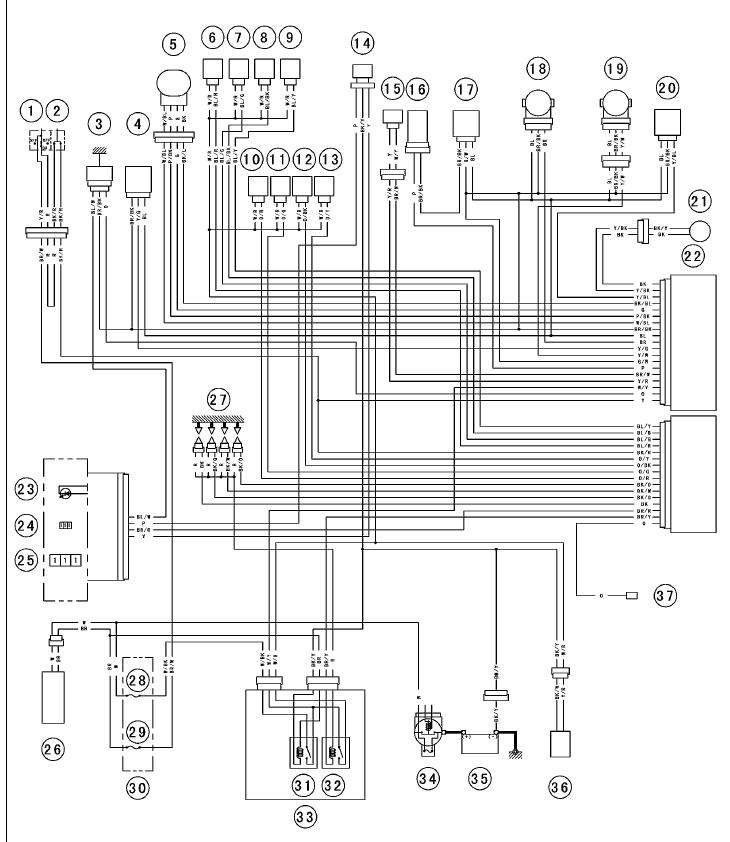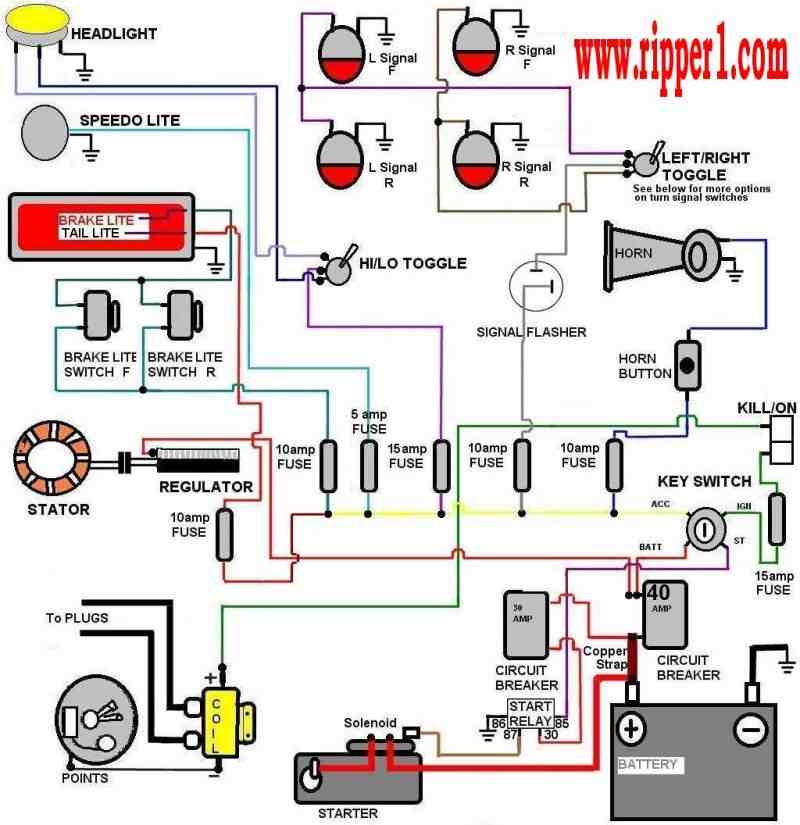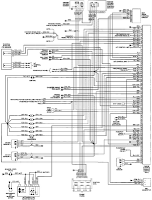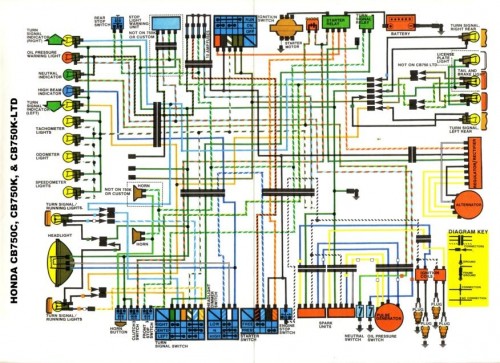
89 S10 Starter wiring Snafu
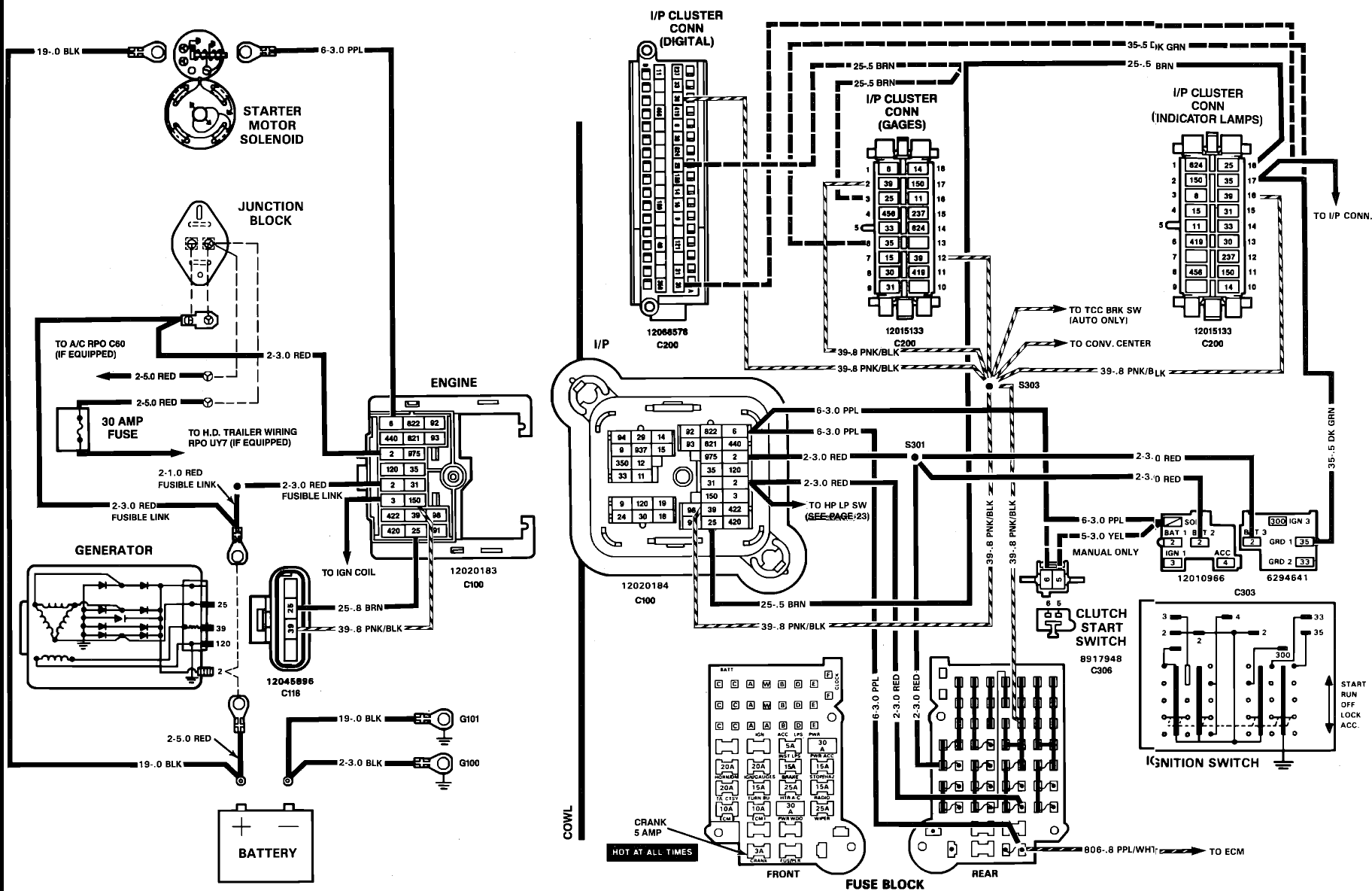
A 1989 S10 with a 4.3L engine and automatic transmission is being reassembled after the engine was removed. The main issue encountered is related to the starter wiring. The solenoid has one large terminal connected to the positive side of the battery and a smaller terminal labeled "S," which is assumed to be hot during starting. A purple wire that appears to connect to this terminal does not seem to be hot but rather acts as a ground. There is uncertainty about the necessary wiring for the starter to function. According to the Haynes manual, a generic wiring diagram is available. The purple wire is identified as the trigger wire for the small "S" terminal, while all other wires are power feeds connected to the large terminal with the battery cable. There is confusion regarding additional wires that should connect to the large terminal, which are needed for the ignition switch, headlamps, and charging system. Currently, only a positive connection to the large terminal and the purple wire to the small terminal are established, while other smaller positive wires run from the battery to the alternator. All accessories are operational, but the engine does not start. The inquiry suggests that a wiring diagram may be necessary to resolve the issue.
The starter motor in the 1989 S10 is a critical component for the engine's operation, relying on precise wiring connections to function correctly. The solenoid, which is an electromechanical switch, controls the flow of electrical current to the starter motor. It features two terminals: the large terminal typically connects to the positive battery terminal, providing the necessary power, while the smaller terminal labeled "S" is designed to receive a trigger signal.
In this case, the purple wire is identified as the trigger wire. It should be connected to the "S" terminal of the solenoid. When the ignition key is turned to the "start" position, this wire should receive voltage, energizing the solenoid and allowing current to flow from the battery to the starter motor. If the purple wire is not hot, it may indicate an issue with the ignition switch or the wiring leading to the solenoid.
It is essential to ensure that all necessary wires are connected to the large terminal of the solenoid. This terminal should not only connect to the battery but also to other essential components of the vehicle's electrical system, including the ignition switch, headlamps, and charging system. If these connections are missing, the starter may not function correctly, even if the solenoid is receiving a trigger signal.
To troubleshoot the starting issue, a thorough inspection of the wiring harness in the vicinity of the starter is recommended. Look for any loose or disconnected wires that might feed power to the solenoid. If additional wires are needed, they should be routed from the ignition switch or other power sources to the large terminal of the solenoid.
If the existing wiring remains unclear, obtaining a detailed wiring diagram specific to the 1989 S10 model will provide clarity on the required connections and assist in diagnosing any wiring issues that may be preventing the engine from starting.Got a 89 s10, 4. 3 with auto trans. someone else pulled the motor I got stuck trying to put it back together. Only problem I have is the starter wiring. Solanoid has one big terminal(goes to hot side of the batt) and one small one with a "S" which I figure is hot during start. The purple wire that looks like it goes there is not hot but more of a ground. What gives Does anyone have a clue on what is it going to take for this thing to start. The Haynes manual I have has a generic wiring diagram for this. Do I need two wires going to this one small terminal Help! The purple wire is the trigger wire and is the only one that goes on the small "S" terminal. All other wires are fusable link power feeds to the car and all go on the big terminal with the battery cable. Reply to Chevy man`s Post: I do not see any other wires in the area that could reach the large terminal either other than the large red bat wire, and it will not turn the starter over hooked up like it is.
I do know it was turning the truck over before the engine was pulled. There should be at least one or two more in the area that go on the large terminal. They feed the ignition switch, headlamps and charging system. They have to be in the area somewhere. I can not find any other wires that are in the vacinity if the starter. What I have is pos to the large side of the starter and purple to the small terminal. The other smaller pos wire goes from the batt to the alt. All of the accesories work, lights, radio. Just no start mode. what can I do to get this thing cranked. If I run a new wire were does it need to go from the large terminal on the starter Sounds like I need a wiring diagram dos`t it. Thanks, any info would help Ask-a-doc Web sites: If you`ve got a quick question, you can try to get an answer from sites that say they have various specialists on hand to give quick answers.
Justanswer. com. Traffic on JustAnswer rose 14 percent. and had nearly 400, 000 page views in 30 days. inquiries related to stress, high blood pressure, drinking and heart pain jumped 33 percent. I was having a terrible problem with the wheel bearings on my 98 Chevy Cavalier and I suspect that using this website saved me plenty of time and money. Todd L Rochester NY I was having a terrible problem with the wheel bearings on my 98 Chevy Cavalier and I suspect that using this website saved me plenty of time and money.
Todd L Rochester NY Wonderful service, prompt, efficient, and accurate. Couldn`t have asked for more. I cannot thank you enough for your help. Mary C. Freshfield, Liverpool, UK This expert is wonderful. They truly know what they are talking about, and they actually care about you. They really helped put my nerves at ease. Thank you so much! Alex Los Angeles, CA Thank you for all your help. It is nice to know that this service is here for people like myself, who need answers fast and are not sure who to consult. GP Hesperia, CA Just let me say that this encounter has been entirely professional and most helpful. I liked that I could ask additional questions and get answered in a very short turn around. Esther Woodstock, NY Thank you so much for taking your time and knowledge to support my concerns. Not only did you answer my questions, you even took it a step further with replying with more pertinent information I needed to know.
Robin Elkton, Maryland 🔗 External reference
The starter motor in the 1989 S10 is a critical component for the engine's operation, relying on precise wiring connections to function correctly. The solenoid, which is an electromechanical switch, controls the flow of electrical current to the starter motor. It features two terminals: the large terminal typically connects to the positive battery terminal, providing the necessary power, while the smaller terminal labeled "S" is designed to receive a trigger signal.
In this case, the purple wire is identified as the trigger wire. It should be connected to the "S" terminal of the solenoid. When the ignition key is turned to the "start" position, this wire should receive voltage, energizing the solenoid and allowing current to flow from the battery to the starter motor. If the purple wire is not hot, it may indicate an issue with the ignition switch or the wiring leading to the solenoid.
It is essential to ensure that all necessary wires are connected to the large terminal of the solenoid. This terminal should not only connect to the battery but also to other essential components of the vehicle's electrical system, including the ignition switch, headlamps, and charging system. If these connections are missing, the starter may not function correctly, even if the solenoid is receiving a trigger signal.
To troubleshoot the starting issue, a thorough inspection of the wiring harness in the vicinity of the starter is recommended. Look for any loose or disconnected wires that might feed power to the solenoid. If additional wires are needed, they should be routed from the ignition switch or other power sources to the large terminal of the solenoid.
If the existing wiring remains unclear, obtaining a detailed wiring diagram specific to the 1989 S10 model will provide clarity on the required connections and assist in diagnosing any wiring issues that may be preventing the engine from starting.Got a 89 s10, 4. 3 with auto trans. someone else pulled the motor I got stuck trying to put it back together. Only problem I have is the starter wiring. Solanoid has one big terminal(goes to hot side of the batt) and one small one with a "S" which I figure is hot during start. The purple wire that looks like it goes there is not hot but more of a ground. What gives Does anyone have a clue on what is it going to take for this thing to start. The Haynes manual I have has a generic wiring diagram for this. Do I need two wires going to this one small terminal Help! The purple wire is the trigger wire and is the only one that goes on the small "S" terminal. All other wires are fusable link power feeds to the car and all go on the big terminal with the battery cable. Reply to Chevy man`s Post: I do not see any other wires in the area that could reach the large terminal either other than the large red bat wire, and it will not turn the starter over hooked up like it is.
I do know it was turning the truck over before the engine was pulled. There should be at least one or two more in the area that go on the large terminal. They feed the ignition switch, headlamps and charging system. They have to be in the area somewhere. I can not find any other wires that are in the vacinity if the starter. What I have is pos to the large side of the starter and purple to the small terminal. The other smaller pos wire goes from the batt to the alt. All of the accesories work, lights, radio. Just no start mode. what can I do to get this thing cranked. If I run a new wire were does it need to go from the large terminal on the starter Sounds like I need a wiring diagram dos`t it. Thanks, any info would help Ask-a-doc Web sites: If you`ve got a quick question, you can try to get an answer from sites that say they have various specialists on hand to give quick answers.
Justanswer. com. Traffic on JustAnswer rose 14 percent. and had nearly 400, 000 page views in 30 days. inquiries related to stress, high blood pressure, drinking and heart pain jumped 33 percent. I was having a terrible problem with the wheel bearings on my 98 Chevy Cavalier and I suspect that using this website saved me plenty of time and money. Todd L Rochester NY I was having a terrible problem with the wheel bearings on my 98 Chevy Cavalier and I suspect that using this website saved me plenty of time and money.
Todd L Rochester NY Wonderful service, prompt, efficient, and accurate. Couldn`t have asked for more. I cannot thank you enough for your help. Mary C. Freshfield, Liverpool, UK This expert is wonderful. They truly know what they are talking about, and they actually care about you. They really helped put my nerves at ease. Thank you so much! Alex Los Angeles, CA Thank you for all your help. It is nice to know that this service is here for people like myself, who need answers fast and are not sure who to consult. GP Hesperia, CA Just let me say that this encounter has been entirely professional and most helpful. I liked that I could ask additional questions and get answered in a very short turn around. Esther Woodstock, NY Thank you so much for taking your time and knowledge to support my concerns. Not only did you answer my questions, you even took it a step further with replying with more pertinent information I needed to know.
Robin Elkton, Maryland 🔗 External reference
